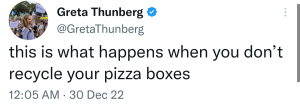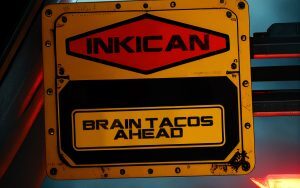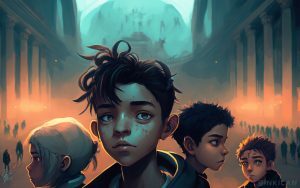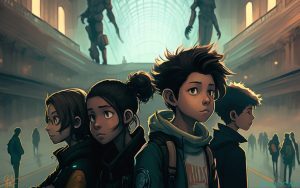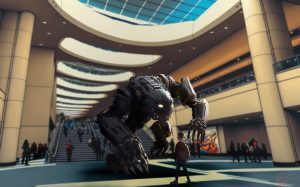Jackson Allen's Blog, page 29
January 10, 2023
Mike.Sierra.Echo In Real Life – Asteroid Fly-By
Always fun when your stories happen in real life – an asteroid fly-by happened a few weeks ago – that’s just like Mike.Sierra.Echo! CNet reports: “An asteroid the size of a car was discovered the same day it made a close approach to Earth, coming closer to the surface than the ring of large telecommunications satellites in geosynchronous orbit.”
InterestingEngineering has more: “Due to its proximity to the Earth, 2022 YO1 is classified as a Near Earth Object (NEO), and it could hit the Earth during one of its future orbits. According to NASA’s page, on December 17, the asteroid flew at a relative velocity of 34,450 miles an hour as it zipped past the Earth. As per estimations of its next orbit, 2022 YO1 could fly as close as 3,380 miles (5,439 km) exactly two years from the day it was first spotted.”
What if 2022 YO1 hits the atmosphere?What happens if 2022 YO1 hits Earth? Likely nothing. 2022 YO1 is too small to be anything other than a shooting star, but it’s nice to know somebody’s watching the skies for a big one! 2022 YO1 was discovered by the Catalina Sky Survey, a NEO Observations Program to identify 1 kilometre (0.62 mile) or larger objects.
In fact, If you want to drop into a DEEP ASTRONOMICAL RABBIT HOLE – start digging into all the objects being tracked by the Catalina Sky Survey, including 2006 JY26, which might hit Earth in 2073. NASA has more to say about this. The Near-Earth Object (NEO) Surveyor is the first space telescope specifically designed to hunt asteroids and comets that may be potential hazards to Earth.
This is of deep interest to me since one of the main characters of Mike.Sierra.Echo is an asteroid – 2340 Hathor is an eccentric stony asteroid, classified as near-Earth object and potentially hazardous asteroid. It’s going to be used as the counterweight to Mike’s space elevator with world-changing, universe-impacting results!
Mike Sierra Echo is a fact-based science fiction adventure that explores the real-world challenges of building this extra-terrestrial technology. Scientists have been researching space elevators since the 1800s, but there are still many unsolved problems. Once you learn about those areas of exploration, you’ll be invited to ‘nerd out’ about current discoveries and new opportunities to fill in the blanks on space travel, nanotech, and artificial intelligences. I’m building a plan on what that looks like, right now.
We don’t know what the future holds but it’s fun to imagine what might happen. Keep your eyes peeled for Mike Sierra Echo by joining the Inkican Crew and keep watching the skies!
January 6, 2023
Sci-Friday #171 – Travel at Warp Speed or In Hyperspace
What would it look like if we could travel at warp speed, or in hyperspace? Watch this video for Sci-Friday and understand what it would look like in real life if we could travel at incredibly fast speeds. Buckle up, Bucko and hit that lightspeed button!
I love the hopefulness of this video. Limitless Space Institute says ‘the purpose of this short film is to identify the perennial time-distance problem of human space exploration beyond Mars and to identify a few propulsion approaches we might utilize to send humans to all the worlds in our solar system and reach out across the vast distances between stars. The spacecraft architectures highlighted in the film are nuclear electric propulsion (known physics, known engineering), fusion propulsion (known physics, unknown engineering), and finally space warps (unknown physics, unknown engineering).’
Of course, faster-than-light (FTL) travel assumes other advances in space exploration. My curiosity and passion for the ‘next step’ in human space travel is why I’m writing Mike.Sierra.Echo – it’s a real-yet-fictional answer to the question: “how would it feel if your Dad was building a Space Elevator?”
I hope you enjoyed this deep dive on faster-than-light (FTL) travel! Please feel welcomed to dive down the rabbit hole of every other Sci-Friday I’ve published in the past couple years. Have a great weekend! 
January 4, 2023
Writing Best-Sellers is Hard – Dan Brown Case Study – II
Continuing from Part I – Everyone knows that writing best-sellers is hard – the case study of Dan Brown reminds us of the opportunity to learn what we can from others’ success. Does that mean we like Dan Brown? Of course not. Jerry Seinfeld found George Costanza to be foolish, Jerry still appreciated George’s talents from time to time:
https://i.imgur.com/i95LZKl.mp4Again: this post isn’t for Brown readers. It’s for the people who say ‘we dislike Dan Brown books but we like Dan Brown’s success.’ Writing’s a tough business, writing best sellers is hard – let’s now review the case study of Dan Brown to crack the code of our own writing success. First step is discussing the lessons learned:
Lessons Learned1. The right book, at the right time, for the right audienceThe moral of the story? Research is necessary – know your market! ‘In order to write for your market,’ Author Marketing Experts say, ‘you need to first be a fan, which means reading voraciously and following authors who write in your genre.’ Do you need a checklist on how to research your market? Reedsy has one, right here.
2. Outliers Must Have SupportersMalcolm Gladwell identified a key marker of success for any ‘up and coming writer’ starting out. Until you’re mainstream, you’re an outlier. If you’re an outlier, you need supporters. “No one—not rock stars, not professional athletes, not software billionaires, and not even geniuses — ever makes it alone,” Gladwell wrote in ‘Outliers.’ Dan Brown had the benefit of the right agent (Heidi Lange), the right editor (Jason Kaufman), and the right publisher (Doubleday) to go along with his talent and work ethic. Finding supporters is harder than it looks. Try Googling ‘how outliers find supporters’ – not only does nobody seem to know, nobody’s even asking the question. I promise to share what I learn once I do find them. 
The controversy surrounding Dan Brown books didn’t destroy them – if anything it drove sales. Brown purposefully wrote a ‘shocking’ premise. The original Reddit post notes similarities in controversy between Dan Brown and The Exorcist’s fake Catholic Church condemnation. The lesson for us isn’t ‘controversy’ but rather ‘conversation.’ What’s the ‘shocking’ premise of your story? We live in a social media-enabled world now, but nothing recommends a book or movie faster than your friend going “hey, did you hear about …?” I need to make conversation surrounding my books. Chances are, you do, too.
4. Success is not linearIn fact, more needs to be said about this. Brown’s success path from college to music to writing took decades to complete. In most cases, I’m sure he encountered roadblocks that represented perfectly logical reasons to give up and start a day job. Brown kept going, and we can, too. We may not study in Seville or have someone who can support our full-time writing career, but we have the same levels of curiosity and grit. My mission is to find Brown levels of success without the Brown levels of sap. Maybe yours is, too.
But wait, there’s more! Authors on Mastodon are also actively trying to solve this problem and they’ve got something to say about how to achieve success. Let’s talk more about why we must keep throwing stuff at the wall:
 Keep Throwing Stuff at the Wall
Keep Throwing Stuff at the Wall“Oh, so I should start writing a book and selling it out of the back of my car at swap meets to be successful!” some might say. No, my sweet summer child. Just because Dan Brown sold his books at swap meets and Stephen King writes 2000 words every day doesn’t mean that this is what YOU must do to be successful. Look at the bigger picture:
Brown tried a number of different ideas and strategies to achieve success but he didn’t KNOW which one would work. Creativity, it seems, is a function of continuing to try and fail and try again, learning from others and about yourself along the way. Believe me, I wish there was a ‘successful Jackson starter kit’ out there at Wal-Mart – but there isn’t.
This doesn’t have to be a bad thing! “I saw John Hodgman a few years ago, who was reflecting on celebrity,” Steven Brewer reports. “People kept asking him how he’d done it. And he wondered himself: What made THIS thing take off and go viral versus the other HUNDRED things he’d done before and after? In the end, he decided it wasn’t replicable. The only thing he was certain of was that if you didn’t keep making stuff then it couldn’t happen. So just keep creating, was his only suggestion. Keep throwing stuff on the wall to see what sticks.”
This quote helps us look at reality with the correct lens – if there’s no ‘successful Jackson’ kit out there for me, there’s no ‘successful’ kit for you, and there’s no ‘successful’ kit for anyone else! Everyone has an equal shot at trying everything until it works. Creativity is one of the last free ways our society allows for socioeconomic mobility – make use of it.
True, some things will be easier for US to try, our circumstances and background taken into account, but that doesn’t mean YOU won’t be able to try. Success is the result of what sociologists like to call ‘accumulative advantage,’ according to Gladwell in Outliers. Sometimes our days will be spent accumulating advantage.
Continue to PonderThese are the lessons I’ve learned from the Dan Brown case study – writing best-sellers is hard, but it’s what I signed up to do. Reflecting and considering these points is a good way for us to start our 2023 writing year. I’m going to continue to ponder what there is to be learned from Dan Brown while maintaining minimum safe distance from his books. Feel free to do the same.
Write on!
January 3, 2023
Writing Best-Sellers is Hard – Dan Brown Case Study – I
If you’re in the writing game you know: Writing Best-Sellers is Hard. Let’s use Dan Brown as a case study to understand how he wrote the right book at the right time to be supported by the right people and see what we can learn from his experience.
Let’s be clear – I hate Dan Brown books. The Da Vinci Code? Angels and Demons? It’s trash. Well-paced trash, but still … trash. The Kardashians of novels. I could spend five blog posts talking about how much they suck. Brown capitalized on the sweet demographic of ‘dumb people who want to think they’re smart’ in the early oughts. Brown books are thrillers with equal part of religious- and techno-babble and his readers lap them up.
So, this post isn’t for Brown readers. It’s for the people who say: ‘we dislike Dan Brown books but we like Dan Brown’s success.’ Is that you? Good, read on then because we have a lot of ground to cover.
To begin with, take this Redditor’s deep dive on the success of The Da Vinci Code which explains Dan Brown’s path to success. As you’ll note, success isn’t a linear path for Brown, but this information sets us up for Part II – what Dan Brown teaches you (and me) about being a successful author:

This sort of question can sometimes be near-impossible to answer; why did the infinite-loop video Badger Badger Badger (video here) go viral in 2003? People like animal videos? Yes, true, but why that animal video and not the infinite number of others? Why Dan Brown’s conspiracy novel and not the many others?
Here we have the useful circumstance (in a historian’s sense) of The Da Vinci Code not being Dan Brown’s first novel, or even the first novel featuring the character Robert Langdon. The first Langdon novel was Angels and Demons (2000) which didn’t sell very well at all, so comparison of the circumstances between the two launches is useful, and Brown himself is quite frank there was a difference in both the novelistic content and how the two books were marketed.
While Dan Brown (collaborating with his then-wife, Blythe Brown) technically started writing in the mid-90s, it was with Angels and Demons that he hit upon, as he put in his own words, “the idea of the thriller as academic lecture”.
I tried to write a book that I would love to read. The kind of books I enjoy are those in which you learn. My hope was that readers would be entertained and also learn enough to want to use the book as a point of departure for more reading.
But! … just a conspiracy hook wasn’t enough. Part of the blame was put on the publisher, Simon & Schuster, who originally promised a 60,000 copy print run with major advertising and a 12 city tour. However, the print run ended up being reduced to 12,000 and Dan and Blythe resorted to self-advertising:
Blythe and I were heartbroken as we had put so much work into this book. Once again, we took matters into our own hands, booking our own signings, booking our own radio shows, and selling books out of our car at local events.
Also, Angels and Demons perhaps was a little mild with its conspiracy leap: it went for the Illuminati, and a conspiracy involving stealing a canister of anti-matter from CERN. The Illuminati — if we’re looking at the book as a combination story / pseudo-history lecture — was not novel enough to get attention.
The duo found a new agent (Heidi Lange) who helped collaborate on subject matter for the next book. They quite intentionally went for, according to various biographical materials, something “controversial” and “shocking”, something that would relate to people’s everyday experience yet turn their idea of that experience on their head. That is, the Illuminati (not in most people’s daily headspace) would not shock, but a plot that Jesus Christ and Mary Magdalene had a child (that later became a lineage of kings) would. It wasn’t strictly novel (Dan Brown lists The History of the Knights Templars and The Goddess In the Gospels among other books) but importantly, it wasn’t well-known.
In the meantime, Jason Kaufman (who was Dan Brown’s editor and main booster at Simon & Schuster) changed jobs over to Doubleday, taking Brown with him. This was done with reticence (Brown’s prior novels, as already mentioned, were not hot sellers) but Stephen Rubin, the president of Doubleday, was impressed enough by the outline of The Da Vinci Code that he gave the deal the green light, and a contract that seemed a bit much for such a small-selling author: $400,000 for a two book contract.
The fact this was based on the outline and not the full book indicates that the publisher was well-aware of the potential impact of the subject matter.
The publisher also took the launch seriously, heavily pushing advance copies (printing 10,000, compare to the first printing of Angels and Demons!) and went for grassroots support as opposed to a physical marketing campaign. Despite large modern condemnation for Dan Brown’s prose, early reviews were favorable; from the New York Times:
The word for ”The Da Vinci Code” is a rare invertible palindrome. Rotated 180 degrees on a horizontal axis so that it is upside down, it denotes the maternal essence that is sometimes linked to the sport of soccer. Read right side up, it concisely conveys the kind of extreme enthusiasm with which this riddle-filled, code-breaking, exhilaratingly brainy thriller can be recommended.
That word is wow.
I wouldn’t say controversy caused the sales — the first printing of 230,000 sold out quite quickly, too quickly for various academics to level their disapproval — but it is true there became a cottage industry of “debunking The Da Vinci Code” which only served to help things along. (Unlike the 1971 movie version of The Exorcist, where the film studio claimed condemnation from the Catholic Church even though it didn’t have any in order to bump up ticket sales, with The Da Vinci Code, there was plenty of real condemnation that could be used to stoke up the hype.)
So, in comparison, the reason The Da Vinci Code did well and Angels & Demons did not is:
a.) Angels and Demons did not have a premise that would be considered shocking of one’s daily world-view; The Da Vinci Code was intentionally written so it would have one
b.) The publisher of Angels and Demons only used traditional marketing, was fairly lax about it besides, and did not have much faith in the product, cutting the initial production run
c.) The Da Vinci Code got a new publisher and agent which recognized they had something hot and resorted to a grassroots push of advance reading copies
You can read more of their analysis here and I encourage you to do so, if you’re curious about the game of ‘being a writer.’ The point of all this discussion goes back to what I said at the beginning: Writing best-sellers is hard. Like, real hard. One-in-a-million hard. Bad odds but like Han Solo is fond of saying:

If I can crack this ‘code,’ then I will have accomplished something few other people have done and that – I think – is a goal worth chasing. Let’s pick up the discussion in Part II – please join me there.
Read Writing Best-Sellers is Hard – Dan Brown Case Study – II (coming tomorrow)
December 30, 2022
Lessons from Andrew Tate and Other Dumpster Fires
The harsh lessons from Andrew Tate are rolling in today but don’t worry: this isn’t another hot-take post on a dumpster fire of a human being. Instead, let’s talk about what lessons Jackson is taking from the entire Andrew Tate debacle. First, never be a person that Greta Thunberg dunks on:
Second – step back and understand how people like Andrew Tate happen. We live in a slow-rolling late-stage capitalistic dystopia and it’s no secret that people are desperate for answers. People like Tate take advantage of that to exploit others – at first I just thought he was interested in money but then we found out the horrible truth. Yeesh.
The Andrew Tate situation perfectly embodies why I’ve slow-rolled what I do with my scifi writing career. Yes, it’s taken me much longer to get where I want to go but that doesn’t bother me. The last thing I want to become is another JK Rowling or Andrew Tate.
The Problem is Bigger Than Andrew TateDon’t get me wrong – Andrew Tate *is* a grifter and along with other people (Looking at you, Robert T. Kiyosaki, Jordan Petersen, and James Frey) exploit people’s need for answers, direction, guidance to join the ranks of the 1% and they don’t care who they hurt in the process.
“It’s easy not to be JK Rowling or Andrew Tate,” they say. “Just don’t be a terrible person and-” Okay, hold it. It’s easy to say “I’ll never be Andrew Tate” – he’s a dumpster fire of a human being (e.g – Bill Cosby, Chris Brown, and Jared Leto) and we were all waiting for him to implode. However, there are other people who aren’t as bad as him but they still self-destructed.

At one point, they were just famous people (e.g. – Andy Dick, Gina Carano, Lance Armstrong). They became terrible people for different reasons: 1. They were always terrible, we were just waiting to find out 2. Drugs. 3. They stopped working on themselves because “Hey, we arrived!”
That might be an oversimplification, but I’m putting this out there to say ‘Not every terrible famous person started out as a terrible person.’ I don’t want to be a terrible person, so if I’m going to be successful I want to wait until I can do that without being a terrible person.
Lessons I Have LearnedSo far, I’ve made promises to myself regarding my writing / success. For example – if I make it:
1. I’m still me – a walking, talking bag of coping mechanisms like everyone else.
2. My job is to reflect the light forward (e.g. – Mister Rogers, Mark Hamill, John Cena, Guy Fieri)
3. Figure out how I should use that success to make the world a better place (Keep my mouth shut and practice mindfulness – Media asking for your ‘hot take’ on current events is a cheap way to get attention but invariably, you’ll say something stupid.)
4. I’ll be following the Bill Watterson school of ‘I’m an artist, please leave me alone with my box of crayons and let me get about my business.’ Calvin and Hobbes was never diminished by Watterson’s reluctance to give media interviews and I’m confident that I can do the same.
One good thing that came out of COVID was it made people face the fact that some things in life cannot be ignored, wished, threatened, or purchased away. The terrifying part of wealth and fame is how it transforms people into their worst selves. You think you’re escaping the prison of poverty only to find yourself in the penitentiary of prosperity. Money changes you, and it changes how people see you. Unknown pressures, and unseen stresses can break people under the best circumstances. Under the worst, they become those craven, cold-hearted souls you see on reality TV.
Living Simply Is Pretty CoolSo yes, living simply. A living space that has room for a cozy reading nook and a place for my cats to sleep. Yes, my life will still need to include the people who are important to me now. That means Mason and Moxie are coming along for the ride, wherever we go. You may be aware that cats are completely uninterested in the idea of large, complicated houses.
Finally, whatever happens in my life I want to make sure I have the time and space to listen to the wind blow. Writing is about distilling life experiences into things you can share with others. Few people can relate to a story about traveling with Dr. Phil in Monaco (Thank you, Ron White, but no thank you). So, I’ll need to continue being my anonymous, private self so that I can continue taking in the life experiences I use in the stories I tell.
Yes, Andrew Tate is a dumpster fire – but you can still learn lessons from him. One lesson? Don’t be a horrible human being. Simple, right? Maybe not. That wraps up the life lessons I’m learning from the Andrew Tate debacle. Some people will need to look in the mirror as their Grifter Internet Life Coach burns out in the atmosphere and I’m glad I’m not one of them.
December 27, 2022
December 2022 – Free Scifi and Cyberpunk Wallpaper Dump
Happy to share some cool new free scifi and cyberpunk wallpapers with you! My work with MidJourney continues and it gives me great pleasure to pass along some of the awesome things the AI art is helping me to make. Take a look:
It’s important to note – MidJourney is not doing all of this by itself! One of the reasons humans can never be replaced by AI artists is, well, they kind of suck. Hours spent with the AI confirm that some things it does well, other times you’re like ‘ya just don’t get it, do ya?’ It’s times like those that you need a human. My hope is one day to have the budget for a professional.
But let’s talk about what we’re looking at – the two pictures above and the two pictures below are concept art pieces from Mesh. The cast of kids inhabit real and virtual worlds, making a ‘killer app’ that turns out to be really killer! Once they crack the code, that’s when the chase begins. All their technical knowledge, their friendships, and their skills have to come together if they plan to survive the next forty-eight hours.
What happens at the end of Mesh? A big robot fight! The Mesh – it’s a real thing, look it up – comes together to defeat the bad guys but the villains won’t give up so easy! Four or five bad guys in construction mecha are no match for a thousand angry kids with a score to settle and a world to save. It gets crazy, it gets fierce, but the Mesh will prove that the future is a beautiful place worth fighting for!
I hope you enjoy these wallpapers – I’m working on more. Can’t wait to see what you think of them.
Write on!
December 26, 2022
DIY Geek – Build Your Own Corsi–Rosenthal Air Filter
Those of you looking for a post-Holiday palate cleanser will appreciate this DIY Geek post – here’s how you can build your own Corsi–Rosenthal Box! Now that winter is upon us, we’re stuck inside for the next few months breathing all that built up dust and whatever viruses and bacteria your antivax uncle brought to the party. Who needs that, right?
This is a nice way for me to forget the cold and rain outside, while giving myself a better air purifier than one of those expensive HEPA filters. A Corsi–Rosenthal Box or Cube is a simple, inexpensive DIY air purifier. It was designed during the COVID-19 pandemic with the goal of reducing the levels of airborne viral particles in indoor settings.
This how-to comes from UC Davis (Link) but I’ve distilled the instructions down to something easier to read for you:
Step One – Get your materials.You’ll Need:
Four (4) MERV 13 filters ($20-40 each)One (4) box fan ($20-40 each – you can often pick these up for free on Craigslist)One (1) roll of duct tapeScissors
Step 2: Build the Basic Structure
Using your duct tape, build a box out of the four filters as shown in the picture above. All four come together, connected by the tape to form the basic structure and the box fan will go on top of that when you’re finished.
Now, it’s important to remember: air filters are designed to flow ONE WAY. They have arrows on the side to show you which direction the air is supposed to flow in:

So make sure you build the box with the arrows on the filter flowing into the center. Otherwise, the filters won’t work correctly. Once you’ve done that, go back over all the edges of your structure – make sure every seam is air-tight with duct-tape.
Step Three: Finalize your Corsi–Rosenthal BoxYou can put the box on the floor directly, or use cardboard as shown in the picture above. Triple-check all your side edges to make sure that the structure is allowing no air through the seams between MERV filters. Don’t worry about taping anything on the bottom. You might get a little air flowing through the bottom, but that’s ok.
Step Four: Seal the Box Fan on Top
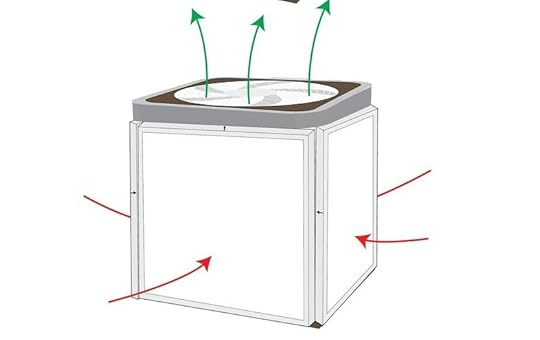
Now we put the box fan on top and make sure it’s air-tight with the rest of the structure. You can use cardboard, duct tape, or plastic wrap if you have some to seal off the edges between the box fan and the rest of the Corsi–Rosenthal Box. This is where you’ll channel your Inner MacGyver to really make sure all edges are sealed. Test the box fan by turning it on and seeing if air pulls in from any place it shouldn’t, and seal that spot with more duct tape.
Step Five: ProfitOnce you’re done, step back and watch your Corsi–Rosenthal Box fly! It’s a simple, DIY geek project that you can build with kids if you need something to keep them busy. Plus, once it’s finished you’ve got a neat little science project you can show off to others. Best yet – your air will be cleaner and you’ll save money. You’re a technical, financial genius!
In many cases, a Corsi–Rosenthal Box operating on low for a portion of a day may last as long as 5 to 6 months. Don’t forget – this isn’t a substitute for masking up! ‘If operated on higher flows and longer durations in a dusty location, the system might only last a month or two. The Corsi-Rosenthal box is not a substitute for high-quality masks. Use of this, or any other air cleaner should be a supplement not a substitute for wearing a mask. Use of a high-quality masks, particularly N95 and KN95, is the most effective way to protect your respiratory system.’
Hope you enjoyed this DIY Geek article on how to build your own Corsi–Rosenthal Box air filter. Clean air is better for you – now you can breathe easier, knowing your Corsi–Rosenthal Box is on the job.
December 23, 2022
Sci-Friday #170 – Try Not to Barf – Space Shuttle Launch
Woo – we made it – try not to barf as the Space Shuttle launches for this Sci-Friday! Take the ride into space and then let’s talk about what was happening during the video:
A number of things happen in the last minute before launch:
Orbiter transfers from ground to internal power (T−50 seconds)Ground launch sequencer is go for auto sequence start (T−31 seconds)Activate launch pad sound suppression system (T−16 seconds)T−10 seconds and counting Activate main engine hydrogen burnoff system (T−10 seconds)Ground launch sequencer commands main engine start (T−6.6 seconds)T−0 seconds Solid Rocket Boosters igniteExplosive bolts release the boostersShuttle stack lifts off from launch padOnce in space, a number of things happen during this video automatically:
T plus 20 s – the shuttle rolls right (180 degree roll, 78 degree pitch).T plus 60 s – shuttle engines are at maximum throttle.T plus 2 min – SRBs separate from the orbiter and fuel tank at an altitude of 28 miles (45 km). Main engines continue firing. Parachutes deploy from the SRBs. SRBs will land in the ocean about 140 miles (225 km) off the coast of Florida. Ships will recover the SRBs and tow them back to Cape Canaveral for processing and re-use.T plus 7.7 min – main engines throttled down to keep acceleration below 3g’s so that the shuttle does not break apart.T plus 8.5 min – main engines shut down.At 6:22, the commander is letting everyone know they just broke 50 miles, which means the entire crew are now ‘official’ astronauts as that’s where space is generally considered to start. Aas of this moment, Pilot Jim Halsell, MS’s Leroy Chiao, Don Thomas and Japanese MS Chiaki Naito-Mukai were all entitled to wear the gold astronaut pin. It’s the biggest hurdle in any astronaut’s career to break the 50 miles mark the first time.
I hope you enjoyed this deep dive on the space shuttle! Please feel welcomed to dive down the rabbit hole of every other Sci-Friday I’ve published in the past couple years. Have a great weekend! 
December 18, 2022
Redditor Does the Math – Proves AI Writers Suck
Breaking radio silence to share an interesting post in which a Redditor does the math and proves that AI writers suck. Boy, do I hate being right all the time. Ready for a deep-dive you can share with your ‘AI is going to take your writing job’ friends? Let’s go!
I revisit the whole ‘how good is AI for creativity’ discussion from time to time and this breakdown was too good to pass up. More and more writers jumping on the ‘I use AI in my writing’ bandwagon remind me of some white trash carpetbagger trying to be the first to strike oil. All you have to do, the theory goes, is let the AI churn out the first draft. Then you come in, clean it up, and you’re an amazing prolific author – huzzah!
Meanwhile, I’m over here going: ‘good for you, Cleetus – you’ve discovered a new way to kill the planet.’ No rational author who is in the business of human connection can honestly say that AI will help get them closer to that endeavor. AI has its place, but it can never take the place of human artists (please read the entire article before you say I’m being hypocritical).
No, AI isn’t taking your art job. Not tomorrow, not next month, not next year – art is a human expression that seeks meaning and connection. The only thing an AI can do is realistically fake that endeavor. It can get close, but it’ll never cross the uncanny valley. This Reddit post helps explain why in both detailed and meaningful ways. Take a look:
The BreakdownLast year over winter break (Nov/Dec 2021), while my family was arguing about what to do for Thanksgiving and I was bored listening to them fight, I decided to try out about 10, maybe 12 different Ai programs that were supposed to be able to write novels.
I saw a thread on Reddit, forget which sub, that was “doomsday preaching” how ai programs were the end of writing careers, oooooh woooe is us, our jobs are gone, boo-hoo… and they listed every novel writing ai out there. Intrigued by how much they thought their life and career was over, I decided to test out these so called doomsday ais that were going to end our writing careers, to see, are they really as good as that user was saying? COULD any of them ACTUALLY write a full novel?
The list had 34 novel writing ai programs, but only 13 of them offered a free trial, and I wasn’t willing to pay money for something I wasn’t even allowed to see a test sample of. So, I only tested out the ones which offered free trials.
I spent most of the week, clicking the next button of each program… an entire dull boring week of nothing but next, next, next, next, next, next, next… and eventually I got 10 “books” written by Ai.
The results were…uhm…interesting?
Each one gives only you one to 5 sentences at a time (240 words per next-click was the highest any of them would go in their free trials, though some said the paid versions did more words), so it takes days of being bored with clicking the next button, before it actually reaches even a 10k word short story (I can type 5k words a day, so I can type in 2 days what it took Ai to type in a week).
Most of the Ai programs stopped at 10k words and then announced my free trial was over as 10k was the max limit, then sent me to the subscription page. Sooo… of the ones I tried, all but 2 stopped at the short story word count of just 10k words, and did not offer the ability to reach novel length word counts.
The only 2 I was able to get past 10k words with was Dreamily and AiDungeon, both of which I was able to surpass 50k word novels in only 3 days each, of clicking next, next, next, next.
 And then …
And then …The CHEAPEST one was $79 a month, with a limit of 10k words per month. Meaning, even after you paid $79, it would give you another 10k words, then go dead for the rest of the 30 days left, and on day 31, after you paid yet another $79, it would recharge for another 10k words.
Uhm… I publish a 15k story weekly, I can write 10k words in a single day, with no trouble. This program was the LEAST EXPENSIVE of the programs and was asking me to pay $80 for something I could do on my own in a single day. What a money scam!
But even then, these programs were spitting out 30% to 80% gibberish mixed with outright plagiarism and huge copyright infringements. I’ll explain in a minute, what I mean by that.
The BEST paid one, best as in most readable end product, was $399 per 200k words typed.
NONE of the paid ones offered enough words typed in a 30 day period to classify the word counts at a novel.
Most of them were going to cost $500 to $2k worth of subscription in order to buy enough typing time for it to type a standard 120k word Fantasy novel.
And then …But then there was the output.
For each one, I started with the first paragraph from a novel I had published in 2014. The 1st paragraph included all 3 main characters, but did not include place names, names of other characters, etc. I wanted to see how different the result of each would be if each was given the same start. The word BoomFuzzy is unique to this novel, and was in that first paragraph.
Guess what? Plagiarism is a BIG, BIG, BIG, HUGE problem with these Ai programs.
ALL of them.
EVERY SINGLE ONE OF THEM.
Apparently each of them has my 2014 published novel in their database because each one of them started adding correct details… eye colour, hair colour, ages, hometown. The paragraph I gave them said the character was named BoomFuzzy, and gave no details about him. The ONLY identifier was that one word.
The Ai quickly spit out sentences calling him a Lich Lord and a Unicorn, stated he lived in a gingerbread house, called him The Elf Eater of Pepper Valley, and stated the gingerbread house was sitting on a volcano located in The Forest of No Return.
That was all information that could in fact be found in the novel published in 2014. But none of that info was in the paragraph I submitted into the Ai program.
It got worse…I pulled out my paperback copy of the 2014 novel to compare results…the Ai programs were pulling out full sentences unchanged.
One of them gave me an entire 500+ word segment of my novel without changing a thing! Outright plagiarism!
 Which Means …
Which Means …My conclusion…it appears that Ai programs are nothing but massive databases of previously published books, and these programs do not actually generate new sentences at all, rather instead, they pull sentences out of previously published novels and scramble them up, then spit them out in a logical order.
But the fact remains…not a single line of original newly generated text came out of a single one of the ai novel writing programs I tested.
Okay? Can We Be Done Now?What’s the takeaway from this detail and nerdery? Simple: AI has its place, but it can never take the place of human artists. It can get close, but AI will never cross the uncanny valley. No, AI isn’t taking your art job. Not tomorrow, not next month, not next year – art is a human expression that seeks meaning and connection.
My thanks to SacredPinkJellyFish – as a Redditor who does the math and proves AI writers suck, they are making the world an better place for every non-AI writer out there. Keep going, your victory is still out there to achieve.
Write on!
December 16, 2022
On the Absence of Empathy
No Sci-Friday this week but cool stuff to talk about below this video – On the Absence of Empathy – which sounds very similar to what I’ve said about empathy in other posts. Take a listen (note: he needs to put $$ in the swear jar after he finishes this):
Pay close attention to what he’s saying because he’s absolutely right: somewhere around half of the population is completely incapable of caring about a thing if it doesn’t affect them personally. That applies to many areas of life, and that includes the science fiction community.
I’ve also experienced the same ‘asking a Labradoodle to solve for x’ behavior when I’ve talked about toxic fans, or the scifi ‘purity test.’ We can disagree on specific points about scifi in general, but it needs to be couched in empathy, the ability to see another person’s point of view, and the possibility that we may not have all the facts. The binary THIS IS RIGHT AND THE REST OF YOU SUCK tone of scifi discourse needs to end. I’m not saying this for me, I’m saying this for all the people who are being harmed by this angry, callous disregard for basic human decency.
Thanks very much for coming to my TED talk.

